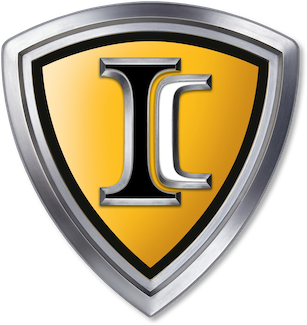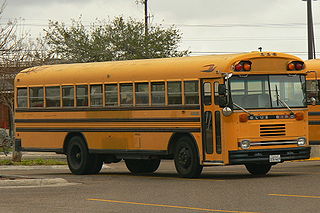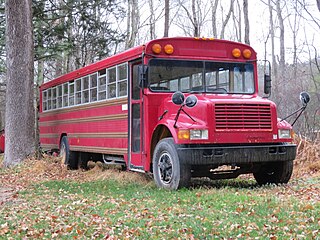
The Blue Bird Corporation is an American bus manufacturer headquartered in Fort Valley, Georgia. Best known for its production of school buses, the company has also manufactured a wide variety of other bus types, including transit buses, motorhomes, and specialty vehicles such as mobile libraries and mobile police command centers. Currently, Blue Bird concentrates its product lineup on school buses, school pupil activity buses (SPAB) and specialty vehicle derivatives.

A school bus is any type of bus owned, leased, contracted to, or operated by a school or school district. It is regularly used to transport students to and from school or school-related activities, but not including a charter bus or transit bus. Various configurations of school buses are used worldwide; the most iconic examples are the yellow school buses of the United States which are also found in other parts of the world.
The Wayne Corporation was an American manufacturer of buses and other vehicles under the "Wayne" marque. The corporate headquarters were in Richmond, Indiana, in Wayne County, Indiana. During the middle 20th century, Wayne served as a leading producer of school buses in North America.

Carpenter Body Works is a defunct American bus manufacturer. Founded in 1918 in Mitchell, Indiana, the company produced a variety of vehicles, with the majority of production consisting of yellow school buses for the United States and Canada.

Navistar, Inc. is an American holding company created in 1986 as the successor to International Harvester. Navistar operates as the owner of International-branded trucks and diesel engines. The company also produces buses under the IC Bus brand. On July 1, 2021, Navistar became a wholly owned subsidiary of Traton, and therefore part of the Volkswagen Group.

IC Bus is an American bus manufacturer. Headquartered in Lisle, Illinois, IC is a wholly owned subsidiary of Navistar International. Established in 2002 by Navistar through the reorganization of subsidiary manufacturer American Transportation Corporation (AmTran), IC currently produces school buses and commercial-use buses for multiple applications.
Corbeil is a defunct trade name that has been used in bus manufacturing. From 1936 to 1975, J.H. Corbeil was a manufacturer of bus bodies; Les Enterprises Michel Corbeil was a body manufacturer that specialized primarily in school buses, opened from 1985 to 2007. In 2007, the company was acquired out of bankruptcy by Collins Industries and renamed Corbeil Bus Corporation. Serving as the Canadian equivalent of Collins Bus Corporation, manufacturing was shifted from Quebec to Hutchinson, Kansas.
Collins Industries is an American bus manufacturer headquartered in South Hutchinson, Kansas. Best known for production of yellow school buses, the company produces buses for multiple applications; all bodies designed by the company have been produced for cutaway van chassis.

The Crown Coach Corporation is a defunct American bus manufacturer. Founded in 1904, the company was best known for its Supercoach range of yellow school buses and motorcoaches; the former vehicles were marketed throughout the West Coast of the United States. Competing alongside Gillig Corporation and similar its Gillig Transit Coach, the two companies supplied California with school buses nearly exclusively into the 1980s.
American Transportation Corporation was an American manufacturer of school bus bodies. Tracing its roots to Ward Body Works, AmTran was formed in 1980 following the 1979 bankruptcy of Ward to continue bus production. In 1991, the company became a subsidiary of Navistar International, leading to a series of acquisitions of school bus body manufacturers by chassis suppliers during the 1990s.
The Wayne Busette is a minibus that was assembled by Wayne Corporation from 1973 to 1990. During its production, many examples of the Busette were produced as school buses. One of the first examples produced with a cutaway van chassis, the Busette mated a purpose-built school bus body with a dual rear-wheel van chassis. In North America, this configuration is now preferred by manufacturers for many other types of minibuses in addition to school buses.

Cutaway van chassis are used by second stage manufacturers for a wide range of completed motor vehicles. Especially popular in the United States, they are usually based upon incomplete vans to be bigger or smaller than pickup trucks and SUVs made by manufacturers such as Chrysler, Ford, and General Motors which are generally equipped with heavier duty components than most of their complete products. To these incomplete vehicles, a second stage manufacturer adds specific equipment and completes the vehicle. Common applications of this type of vehicle design and manufacturing includes small trucks, school buses, recreational vehicles, minibuses, and ambulances. The term "cutaway" can be somewhat of a misnomer in most of the vehicle's context since it refers to truck bodies for heavy-duty commercial-grade applications sharing a common truck chassis.

The Wayne Lifeguard is a type C school bus built by Wayne Corporation, introduced in 1973. Produced until Wayne Corporation declared bankruptcy and was liquidated in late 1992, the Lifeguard was also produced by successor Wayne Wheeled Vehicles until their closure in 1995. The Lifeguard introduced new methods of design and construction for school buses to improve their collision.

Crane Carrier Company (CCC) is a manufacturer that specializes in construction truck and garbage truck chassis. Located in New Philadelphia, Ohio, it was established by Robert Zeligson in 1946, along with the affiliated Zeligson Trucks. Since 2021, CCC has been owned by electric vehicle developer Battle Motors.

Trans Tech Bus, a division of Transportation Collaborative Inc., is an American manufacturer of conventional and environmentally friendly electric Type A school buses. Established in 2007 as a successor to the defunct U.S. Bus Corporation, the company produces Type A & Type A-II School Buses and various models of commercial buses, all built on cutaway vehicle chassis.

The Blue Bird TC/2000 is a product line of buses that was produced by the American manufacturer Blue Bird Corporation from 1987 to 2003. Introduced as a second transit-style product range alongside the Blue Bird All American, the TC/2000 was produced in front-engine and rear-engine layouts. While produced primarily as a yellow school bus, Blue Bird offered the TC/2000 in commercial configurations and numerous custom-built variants. For commercial use, Blue Bird badged the model line as the TC/2000 or the APC 2000.

The bus chassis variant of the International S series is a cowled bus chassis that was produced by International Harvester from 1979 to 2001. Produced primarily for school bus applications, the chassis was also produced for other applications, including commercial-use buses and cutaway-cab buses. In addition, the cowled chassis formed the basis for front-engine and rear-engine stripped chassis produced for bus applications.

The ThomasMinotour is a bus body manufactured by Thomas Built Buses since 1980. The smallest vehicle sold by the company, the Minotour is a bus body designed for cutaway van chassis. Primarily sold for school bus usage, the Minotour is also produced as a MFSAB or in specialized configurations specified by the customer.
The Wayne Lifestar is a product line of buses that was manufactured and marketed by Wayne Corporation and its successor company Wayne Wheeled Vehicles from 1986 to 1995. Produced nearly exclusively in a school bus configuration, the Wayne Lifestar used a transit-style body configuration with a front-engine chassis. Marking the return to transit-style production, the Lifestar adopted the single-piece body stampings of the Wayne Lifeguard in its construction.

Ward Body Works was an American bus manufacturer. Headquartered in Conway, Arkansas, Ward specialized in yellow school buses, alongside buses for other uses. Founded in 1933 by D.H. "Dave" Ward, the company was family-owned for nearly its entire existence.













